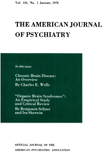Abstract
This paper is concerned with the psychotherapeutic problem of resolving the autistic barrier maintained by the patient who negotiates his relationships to others primarily by means of the schizophrenic pattern of self-inhibition and withdrawal, a pattern which also precludes any ready establishment of effective emotional contact with the therapist. The case of an autistic child who maintained such a barrier in almost pure culture is presented. The tactical approaches used in the therapy of this child and his responses are described, and certain procedures which it is felt may have general validity in the psychotherapy of the schizophrenic personality are discussed. From the experience with this case and others it seems possible to draw the following conclusions:
1. The presence of the schizophrenic pattern is associated with an incapacity for spontaneous participation in relationship with another person, including the therapist. However, some capacity for receptive response to certain kinds of approach by another person is present.
2. The therapist, as the person whose immediate objective is to establish emotional contact with the patient, must assume the initiative in negotiating this contact.
3. The patient, in terms of his moment-to-moment attitudes and responsiveness, must be accepted by the therapist as the pivotal point around which the therapeutic relationship forms. The therapist who maintains expectations that his own attitudes and insight as the doctor will be accepted by the patient as the pivotal point around which to revolve is likely to find himself in a situation of therapeutic stasis.
4. When the therapist approaches the patient with the unconditional objective of attempting to be understanding of what and how the patient feels at the moment, some significant contact with the patient can be expected. What form the therapist's understanding takes seems less important therapeutically than that he is attempting to be understanding.
5. As the patient accepts the therapist's approach, however limited the area or degree of response, he is beginning a rudimentary experience of relatedness with another person.
6. As this experience of relatedness between patient and therapist is maintained, the therapist gradually becomes an emotionally significant person to the patient.
7. The patient now begins not only to respond to the person of the therapist, but to express feelings toward him and interest in his reactions. That is, the patient is no longer just receptive, but the rudiments of assertiveness and reciprocity appear.
8. Spontaneous mutual interaction between the patient and the therapist increases and with it the resolving of the autistic barrier in the therapeutic relationship.
9. Through this experience of relationship with the therapist, the patient's self-dependence, self-esteem and general spontaneity increase.
10. Other persons in the patient's environment besides the officially designated therapist may be serving a similar therapeutic function, as acceptable persons with whom the patient may develop spontaneity.
11. Broadened social participation in relationships with other persons than the therapist begins, as the patient's growing confidence in himself as a person diminishes his need for the protective isolation which he had previously insured for himself through the schizophrenic pattern and the austistic barrier.

